First-Hand Observations and Recommendations for Assessing Other Structures Part 1
By: Janine M. Pardee, P.E. and Sidney T. Burns, P.E.
Disclaimer
The following information is provided based on opinions and field observations of a registered professional structural engineer with 40+ years of experience who spent more than a week at the Subject site immediately after the event. The opinions and observations expressed herein are strictly an opinion and do not represent the official findings or conclusions of that registered professional structural engineer, the author, any consultant, committee, trade association, governmental entity or others.
Observations Regarding the Cause and Effect
- The building’s structure was very poorly deigned:
- Structural plans and specifications were minimal
- Multiple plan set revisions; structural modifications may not have been well coordinated or documented
- Poor selection of frame design, i.e., concrete plate slab and column construction with inadequate number and size of beams (i.e., there were virtually no beams except where parking level column layout differs from the 1st and 2nd floor layouts)
- Inadequate reinforcing that would not meet current building code requirements
- Missing reinforcing where needed
- Misplaced reinforcing
- Inadequate number of shear walls, particularly in the east-west direction
- Discontinuous horizontal and vertical load paths
- The building was poorly constructed:
- Not constructed in accordance with plans and specifications
- No as-built plans provided and reviewed
- Demolition crews core drilling to place charges reported that concrete was “soft”
- Reports that slabs were “thin”
- Column reinforcing and cross sectional area did not have adequate spacing for concrete between the reinforcing bars
- Elevated slabs were inadequately tied to the shear walls
- Reinforcing pulled out of slab sections
- Connections that should have been reinforced had minimal or no reinforcing
- Inadequate inspection by the local Jurisdiction
- Initiating event:
- The collapse appears to have initiated at or near the south wall of the midsection, either in the patio slab adjacent to the south wall or under the south wall
- The specific structural failure that initiated the event is unknown at this time; the answer, if ever found, lies at the bottom of the debris pile
- The collapse initiated at the bottom of the structure and progressed upwards
- The failure mode was punching shear failure:
- The columns punched through the elevated floor slabs as the slabs fell
- As the slabs punched through at the column connections, the columns lost lateral bracing and failed
- Classic pancake collapse
- The west end did not immediately collapse, likely due to:
- The presence of the largest shear wall
- Shear resistance of the elevator shaft walls
- Post-Mortem
- Special and Threshold Inspections laws and regulations were instituted a few years after the building was completed, so the building was constructed prior to Threshold Inspections. The quality of construction has improved considerably since implementation of required Special and Threshold Inspections, and licensing of Building Department Inspectors around 2000.
- In Florida, and possibly in larger, more sophisticated Jurisdictions, inspectors are licensed and their inspections are tracked so issues can be traced to the inspector that signed off the work. This has served to improve inspectors’ training and qualifications and reduce corruption and incompetence of those performing inspections on behalf of the Jurisdiction.
- Foundation failure and geotechnical issues do not appear to have been a causative or contributing factor
Given the building’s poor design and construction, any single critical structural failure could have served as the initiating event for the collapse.
Curricula Vitarum
Janine M. Pardee, P.E. - Janine is a structural and mechanical engineer specializing in forensic engineering, structural design specialties, and ride and show engineering. She is highly experienced in building and mechanical design, catastrophic damage investigations, forensic analysis, Code compliance, and inspections. Janine received a Bachelor of Civil Engineering degree from Georgia Tech in 1976, and is a Florida registered Professional Engineer. She holds a 1980 Civil/Structural Engineering License, a 2002 Mechanical Engineering/Machine Design Engineering License, Florida State Certified General Contractor license (inactive), and is also licensed as a Certified Structural Masonry Inspector (FCPA), Florida Certified Ride Inspector, and Certified Diver. In addition to authoring several published articles and courses, She is an ASTM member and voting member on six ASTM Committees. She is an Affiliate of the National Association of Forensic Engineers (NAFE) and American Concrete Institute (ACI) Central Florida, and holds memberships in the National Society of Safety Professionals, and the Florida Structural Engineers Association, where she serves on the Board of the Central Florida Chapter.
Sidney T. Burns, P.E. - Sid is a Principal of Due Diligence Associates, Inc., specializing in performing commercial property condition assessments and construction loan monitoring for lenders for commercial, retail, industrial and multifamily developments, including low income housing, market rate, and historic tax credit projects. Sid received a Bachelor of Civil Engineering degree from Georgia Tech in 1976, and is a Florida registered Professional Engineer. He has over twenty-five (25) years experience performing hundreds of commercial property condition assessments, thousands of construction site visits and preparation of hundreds of front-end analysis reports, including reports for Fannie Mae and Freddie Mac. His experience includes consulting on difficult projects such as structural failures (e.g., roofing collapse, foundation settlement), geotechnical issues (e.g., sinkholes, soil heave) and other forensic investigations by coordinating analysis with structural engineers, geologists and other subject matter experts. Sid is a Board Certified Building Inspection Engineer and a member of the National Society of Professional Engineers, and National Academy of Building Inspection Engineers, where he has served for ten years as Secretary, Treasurer and Board Member.



